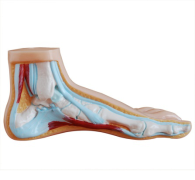

Article tag: Foot anatomy model| medical anatomy model|
The value of foot anatomy model in medical education and training is reflected in many aspects. It is not only an important auxiliary tool in medical teaching, but also a key means to improve the practical ability and clinical skills of...
The value of foot anatomy model in medical education and training is reflected in many aspects. It is not only an important auxiliary tool in medical teaching, but also a key means to improve the practical ability and clinical skills of medical students. The following is a specific explanation of its value:

First, visually show the foot structure
Foot anatomical model can highly reconstruct the complex structure of the foot, including bones, joints, muscles, ligaments, etc. This intuitive display helps medical students to understand the shape, position and interrelationship of each part of the foot more clearly, and lays a solid foundation for the subsequent medical course learning.
Second, enhance practical ability
In medical training, foot anatomical models provide students with hands-on opportunities. Through the practical operation model, students can simulate surgical operation, observe pathological changes, etc., so as to exercise their operational skills in practice and improve the diagnosis and treatment of foot diseases. This kind of practical training is helpful to shorten the transition time of medical students from theory to clinical practice and improve the efficiency and safety of clinical practice.
Third, promote the combination of theoretical learning and practice
Foot anatomy model combines the theoretical knowledge of foot anatomy with practical operation, so that students can better understand and master the knowledge in the learning process. By comparing the similarities and differences between the model and the real anatomical structure, students can have a deeper understanding of the key and difficult points of foot anatomy, and deepen their memory and understanding of the knowledge. At the same time, the problems and challenges in practical operation can also stimulate students' curiosity and exploration spirit, and promote them to learn and think more actively.
Fourth, cultivate clinical thinking and innovation ability
The use of foot anatomy models in medical education and training also helps to cultivate students' clinical thinking and innovative ability. Through the observation and analysis of models, students learn how to apply anatomical knowledge to interpret and solve clinical problems. At the same time, practical training such as simulated surgical operations on the model can also stimulate students' innovative thinking and creativity, and encourage them to try new surgical methods and treatment strategies.
5. Adapt to different learning needs
With the continuous development and innovation of medical education, foot anatomical models are constantly updated and improved. Modern foot anatomy models not only have a higher degree of imitation and interaction, but also can be customized according to the learning needs of students. This flexibility enables foot anatomy models to better adapt to the learning needs and teaching requirements of different students, improving the effectiveness and quality of medical education and training.
To sum up, foot anatomical models have irreplaceable value in medical education and training. It can not only help students better understand and master the knowledge of foot anatomy, but also improve their practical ability and clinical skills, and cultivate their clinical thinking and innovation ability. Therefore, foot anatomical model should be utilized as an important resource in medical education and training.